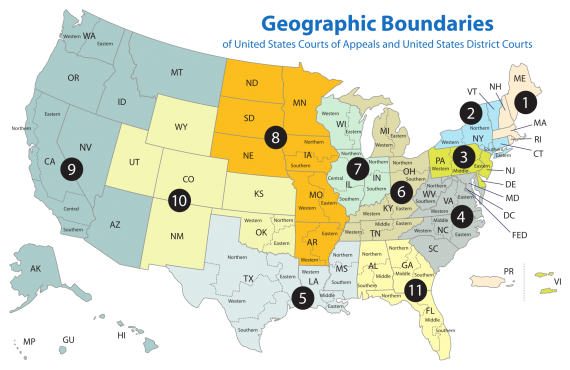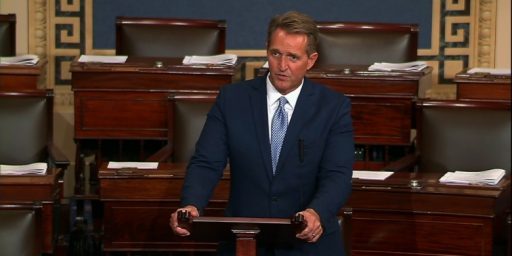Republicans Looking At Plans To Break Up The Ninth Circuit
Independent of the current controversy surrounding President Trump's immigration order, Republicans in Congress are looking at a plan to break up the Ninth Circuit Court of Appeals.
While the Trump Administration deals with an adverse ruling from the Ninth Circuit Court of Appeals, Republicans in Congress are returning to an idea that they’ve tossed around in the past but never really followed through on, breaking up the Ninth Circuit:
As judges on the 9th Circuit Court of Appeals weigh the legality of President Trump’s immigration executive order, a Republican push to split up the controversial court — and shrink its clout — is gaining steam on Capitol Hill.
Republican Sens. Jeff Flake and John McCain of Arizona introduced legislation last month to carve six states out of the San Francisco-based court circuit and create a brand new 12th Circuit.
They argue that the 9th is too big, too liberal and too slow resolving cases. If they succeed, only California, Oregon, Hawaii and two island districts would remain in the 9th’s judicial fiefdom.
Right now, Flake said, the circuit is far too sprawling.
“It represents 20 percent of the population — and 40 percent of the land mass is in that jurisdiction. It’s just too big,” Flake told Fox News on Wednesday. “We have a bedrock principle of swift justice and if you live in Arizona or anywhere in the 9th Circuit, you just don’t have it.”
Flake says it typically takes the court 15 months to hand down a decision.
“It’s far too long,” he added.
Conservatives have mocked the 9th Circuit for years, often calling it the “Nutty 9th” or the “9th Circus,” in part because so many of its rulings have been overturned by the U.S. Supreme Court
The court has a reputation as one of the most liberal in the country, in large part because of its makeup. Eighteen of the court’s 25 active judges have been appointed by Democrats. Former President George W. Bush appointed six justices, while former President Barack Obama appointed seven.
Under Flake’s bill, the new circuit would cover Nevada, Washington, Idaho, Montana, Arizona and Alaska, leaving the 9th with three Pacific states as well as the Northern Mariana Islands and Guam.
A separate House version introduced by Rep. Andy Biggs and four other Arizona Republicans would leave Washington state in the 9th Circuit.
Congressional efforts to split the circuit go back to 1941.
“The problem is the judges in the 9th Circuit, particularly the liberal judges, don’t want to give up any of their jurisdiction,” Flake said.
Congress created the court in 1891. At the time, the area was sparsely inhabited – only four percent of the U.S. population lived in the area compared to today’s 20 percent.
In 1998, Congress appointed a commission to reexamine the federal appeals courts’ structure. The commission ultimately recommended against splitting the 9th Circuit.
But carving up the large circuit isn’t out of the realm of possibility. In 1929, Congress split the 8th Circuit to accommodate a population boom and increased caseloads.
The Ninth Circuit has been a target of conservatives for some time now, of course, due to decisions that are seen as being overly biased toward the liberal side of the legal spectrum. In addition to high-profile cases involving issues like same-sex marriage and other cases involving LGBT rights, the Circuit is also seen as having a liberal bias on issues involving criminal defense, the rights of immigrants in deportation proceedings, and other issues. This is often despite the fact that the Supreme Court has often sustained the Ninth Circuit’s rulings in these areas, to the chagrin of many conservatives. Additionally, it’s worth noting that while the Ninth Circuit does often seem to lean further to the left than, say, the Fifth Circuit Court of Appeals, this is largely due to the fact that it continues to retain a large number of members appointed by Democratic Presidents. Additionally, since many of the states that make up the Ninth Circuit are dominated by Democrats, the Judges that are recommended for Circuit Court and District Court Judgeships end up being leftward leaning. It’s also worth noting that notwithstanding the supposed liberal bias of the Ninth Circuit, the Court also includes a number of conservative jurists. The most prominent of these is probably Judge Alex Kozinski, although Kozinski has a libertarian bent on many legal issues that doesn’t exactly please many hardcore conservatives. In any case, it’s true that conservatives have been “at war” with the Ninth Circuit for quite some time now.
Conservatives also cite the alleged claim that the Ninth Circuit has an unusually high rate of being overturned by the Supreme Court as justification for breaking it up. When you look at the details and the actual numbers, though, as both Politifact and conservative blogger Ed Morrissey of Hot Air have done recently, it’s clear that there’s little merit to that claim. It is true that the Ninth Circuit does account for a large segment of the appeals the Court accepts, and that the majority of those cases accepted for review are overturned, this doesn’t necessarily mean anything. For one thing, the number of cases accepted for review is infinitesimally small compared to the number of cases that the Ninth Circuit decides in a given year so it’s hard to draw any conclusions at all regarding the quality of the Circuit’s work from that number. Additionally, when the Supreme Court accepts a case for review it typically means that there are at least four Justices who believe that there is a reason for the nation’s highest court needs to review the case. This means that the number of cases originating from the Ninth Circuit, or indeed any Circuit is not an unbiased sampling of the cases the Court decides in a given year but instead consists of cases that appear to be vulnerable already, meaning that it is more likely than not that the sample selected by the Supreme Court will be overly weighted down by cases where the decision below is more likely than not to be overturned. Finally, the fact that a case is overturned by the Supreme Court doesn’t necessarily mean that the decision below was incorrect. It could simply mean that the Circuit Court made its decision based on precedent or statutory law that the Supreme Court subsequently finds to be incorrect or unconstitutional. In that type of case, the court below isn’t really “wrong,” and in fact arguably acted correctly in presuming that it was limited by existing law and precedent in making its ruling rather than establishing new precedent, which is typically the job of the Supreme Court.
In any case, there is a good argument other than ideology or alleged errors by the Circuit in favor of breaking up the Ninth Circuit and creating a new Circuit that would become the 12th Circuit Court of Appeals. By far, the Ninth Circuit is the largest in geographic area, extending as far east as Montana’s border with the Dakotas, as far north as Alaska, and as far west as Hawaii and the territories of Guam, the Northern Mariana Islands, and Wake Island on the other side of the International Date Line. It also covers the largest segment of the U.S. population and has the largest amount of Judges. Despite this, or perhaps because of it, the Court is among the slowest in issuing decisions and scheduling hearings in cases that have been appealed to it, including both cases raising important issues of Constitutional law and those dealing with criminal cases and the fate of people sitting in jail pending appeal. With 23 Judges on the Court, the Ninth Circuit is the only Circuit Court in the nation that does not include all the Justices when it hears cases en banc. Instead, those cases granted an en banc appeal are heard by a panel of 11 Judges chosen randomly from among the 23 active Judges, something which some legal scholars is far from ideal. Given all of that, there is a very good argument in favor of breaking up the Ninth Circuit for the sake of litigants, Judges, lawyers, and the justice system itself.
Looking at the reform plan that’s presently being suggested, though, it seems to me that it could be done in a far more efficient manner that actually makes geographic sense rather than one that is imbued with politics. Under the plan that Senator Flake has presented, the Ninth Circuit would consist of Oregon, California, Hawaii, and the Pacific territories. The new 12th Circuit, on the other hand, would include Arizona, Nevada, Idaho, Montana, Washington, and Alaska. While I don’t have access to the number of cases that come out of each of those states, it’s obvious that California likely accounts for the largest number of cases in the current Circuit, and that the territories likely account for the smallest amount. Just looking at the map, it strikes me that a far more efficient map would keep California, Arizona, Nevada, Hawaii, and the Pacific territories in the Ninth Circuit while creating a new Circuit out of Oregon, Washington, Idaho, Montana, and Alaska. This would reduce travel time for Judges and provide both Circuits with a more politically balanced makeup than exists under Flake’s plan. For the plan to work best, I suppose one would need to know the number cases that typically come from each state, which is data I don’t presently have access to and haven’t been able to find on the Internet. Presuming however that the case load for the two Circuits can become basically evenly balanced, then it split would make sense. Otherwise, the Ninth Circuit would remain overly swamped and the Twelfth Circuit could end up being among the least active in the nation in terms of caseload, which would be a waste of judicial resources.
There are plenty of issues, both political and otherwise, that would need to be resolved before any break-up plan could be considered. The first among those would be the Judicial make up of the two circuits. Presumably, the majority of the Judges for the new Circuit would come out of the existing Ninth Circuit panel but that would result in many practical concerns, including but not limited to the requirement that many Judges relocate from their current locations and the question of where any new Judges would come from. This would apply not only to the Judges of the Circuit Courts themselves, but also the District Court Judges underneath them. It’s also unclear what role existing Ninth Circuit precedent would play in the new Twelfth Circuit, although one presumes that it would continue to be applicable unless and until overruled by the new Twelfth Circuit. As long as these practical questions can be answered, though, it strikes me that breaking up the Ninth Circuit is an idea whose time is long overdue.







In an alternate-reality America wherein the GOP isn’t made up almost entirely of power-mad authoritarians who consistently put party before country, yeah, it could.
Unfortunately, that’s not our America.
The Republicans want to increase the size of government? Say it ain’t so.
They could save time by just admitting that they want more conservative rulings and don’t really care how they get them.
Mikey,
Yes but any reform plan is going to have to make it past the Senate and the legislative filibuster, so if this becomes something other than an academic argument it’s going to have to have more than just Republican support.
@Doug Mataconis: True. I’m just feeling unusually snarky today.
Gerrymandering the judicial system. Nice going GOP!
Creating another district would mean creating even more judicial positions Congress will never get around to completely fill. Of course, in creating the new district, the GOP would be happy to use its current majority in Congress and control of the White House to pick additional judges.
It’ll all be better when California secedes.
As to precedent, I suspect there are recent precedents. (Not really a pun, but intended.) It was not that long ago (1981) that the 11th split from the 5th. Like you, I assume the legacy precedent would apply in both new circuits before they carved out their separate paths.
I have no objection from an administrative view, where the split seems to make sense. But the urban population core of whatever circuit includes California will always be California with California politics and culture. The California population size will also require more judges. Moreover, whatever states get roped in with California will represent a smaller counterweight to California. Perhaps Senator Flake’s constituents won’t have to deal with it, but, love it or hate it, the 9th Circus will live on.
Knock yourselves out on this one, Congress.
The 9th has included Montana since 1891 and AZ since 1920. With the invention of the airplane (it was in all the papers) it effectively got a lot smaller. As long as it includes the islands, the proposed changes don’t make it significantly smaller. The geographic argument is simply silly. There is some basis for a change based on the growth of population in the western states. But this mostly sounds like what @Argon: said, gerrymandering. Oh well, I guess GOPs should do what they’re good at, cheating.
Ninth Circuit: “The hold on President Trump’s Executive Order on immigration and travel is maintained”
Republican Party: “Okay, that does it! How can we rig the Ninth Circuit to get the result we want?”
Jason Chaffetz:: (((waving arms frenetically))) “I know, I know! We can open multiple investigations of these 3 judges, or maybe all of them!”
Republican Party: “Why not just legislate a change so that conservative judges from less populated states are most likely to be deciding cases in our favor?”
Jason Chaffetz: “Just like how we’ve de-facto rigged state elections to our favor by gerrymandering congressional districts?”
Republican Party: “God, we’re grease balls.”
Paul Ryan: “Not me, I have principles.”
Mitch McConnell: “Oh please, cut that that Cinderella bulls*** Paul.”
I’ll let them split up the 9th Circuit provided in exchange we get rid of whatever court it is in Texas that produces 90% of the patent troll cases.
Or… They could re-partition the states and keep the number of courts the same. Naw, that’s too sensible and it wouldn’t allow judge stuffing.
@HarvardLaw92:
To be fair, as I note there are good arguments for considering this idea based on the size of the court, it’s caseload, and the delays that litigants are forced to wait through. These are some of the same issues that led to the decision to split the 5th Circuit up to create the 11th Circuit several decades ago.
In normal times, I would agree with this, but these are not normal times — we need signs of the Republicans actually attempting to govern for all Americans, rather than just their base before we allow an undivided government to rearrange courts.
Actually, this should wait until the next time we have a divided government — make sure everyone is represented.
Regarding caseloads, it certainly doesn’t help that the Court of Appeals has about 10% positions still vacant.
@Argon:
Actually, the Ninth Circuit only has four vacancies, and three of which only arose in the final months of 2016. Each of the vacancies was created when the Judge elected to take Senior Status, which means they are still available for assignment. Indeed, there are presently 19 Senior Status Judges in addition to the 25 on active status.
These plans to break up the Ninth Circuit come and go. Roughly every ten years. There was a plan back in the 70s, another in the 80s, and there was a blue ribbon panel that issued a plan for doing it back in the 90s.
The Ninth Circuit is obviously unwieldy. IIRC it has twice as many judges as any other circuit. It was constituted when the West had a population much smaller than it does at present.
I honestly don’t understand the politics. Oh, I understand why there’s a spasm of interest in breaking it up every so often. I don’t understand why it’s held together.
@Doug Mataconis:
Of course there are good arguments to be made, but let’s not allow that to disguise what I think most people would agree is the actual motivation here. This plan packs the liberal district courts into a single district, while lumping Washington State in with a host of conservative states. They neatly divided the circuit along partisan lines while diluting Washington’s influence.
Nah, this one is all about producing more conservative rulings.
@HarvardLaw92:
It is difficult to conclude otherwise.
Just how would splitting the 9th Circuit somehow diminish the power of the judges there? All the circuits are equal and autonomous; it would not remove a single currently sitting judge from office, nor remove them from any power. It would basically reassign all sitting judges in certain areas to the new Circuit. Any new personnel would be purely administrative, not actual judges.
The problem here is the hysterics on both sides being totally paranoid about the matter. The right sees it (wrongly) as a way to dilute the power of the 9th Circuit, and the left sees it (wrongly) as a threat to the part of the judiciary that tends to consistently favor them.
It’s time the saner heads on both sides rein in their nutcases. This is an idea that needs to happen, and will benefit neither side at the expense of the other.
@Walther:
Someone needs to type “forum shopping” into a search engine.
(Just in case it wasn’t clear, that someone is you.)
Thanks for taking time out of your day to offer a disingenuous response. but smart people can see right through it.
@Pch101: “Forum shopping?” Isn’t that how the current order suspending Trump’s travel ban got started?
And “smart people” — careful, you might sprain yourself patting yourself on the back that enthusiastically.
The district will still exist, the judges will still have seats, things will just be a smidgen more administratively efficient.
Your knee-jerk “if some Republicans like it, it’s gotta be EEEEVIL” is NOT the response one would expect from “smart people.” “Smart people” would look at the idea on its own merits and judge for themselves.
@HarvardLaw92: Agreed. If anything the Pacific Coast states would tend to have more in common than with the others. Sure, split the 9th but rearrange states with the 10th.
@Walther:
I’m not sure anyone is legitimately this obtuse.
It doesn’t take a rocket scientist to grasp that the net effect of this would be to limit the reach of a liberal court of appeals to three states and two islands nobody remotely cares about, while swinging six states to conservative reach.
And no, the elected officials of a state pursuing a lawsuit with the intent of protecting the interests of said state in the federal district court which covers that state’s capital (and which is comprised of 10 Republican nominees out of 13), and taking the judge that gets assigned, is not venue shopping. Venue shopping is the NRA, which is headquartered in the Eastern District of Virginia, filing lawsuits in district courts in Texas, Oklahoma, etc. in the pursuit of judges more amenable to their viewpoints.
@Walther:
First, the right-wing spends the last several days grousing about the horrible, leftist “9th Circus”.
Then the right-wing starts talking about breaking up that same aforementioned 9th Circuit.
If it looks, sounds, acts and quacks like a Republican who wants to manipulate the system for the benefit of his party, then it probably is.
@Walther:
Note: venue shopping – in this instance – would have been them filing the suit in the eastern district of Washington, which is 7 Democratic nominees out of 10. Unlike some conservatives, these people acted ethically in choosing where to file, even when doing so put them at a decided disadvantage going in the door.
That a Republican nominee ruled as he did should tell you just how flawed this EO really is.
@HarvardLaw92:
That’s why I don’t neessarily support Flake’s bill. It’s clearly based as much on politics as anything else. A Circuit that stretches from Alaska to Arizona makes little sense. Instead, a plan that essentially splits the 9th Circuit into “northern” and “southern” zones by keeping Arizona and Nevada in the 9th makes a lot more sense. That would make the new Circuit of Washington, Idaho, Montana, and Alaska,. The only caveat, as I say in the post, is that I don’t have access to caseload-by-state statistics so it may be that this geographic plan would leave the 9th with a still-overloaded caseload and a 12th Circuit that didn’t have enough to do.
@Doug Mataconis: If you’re still looking for caseload stats, check the US Sentencing Commission. They only track criminal prosecutions, but it’s a snapshot. Interestingly, their stats indicate that the 5th Circuit takes more criminal appeals than the 9th.
@HarvardLaw92: Why would one even bother to look for an alternative explanation?